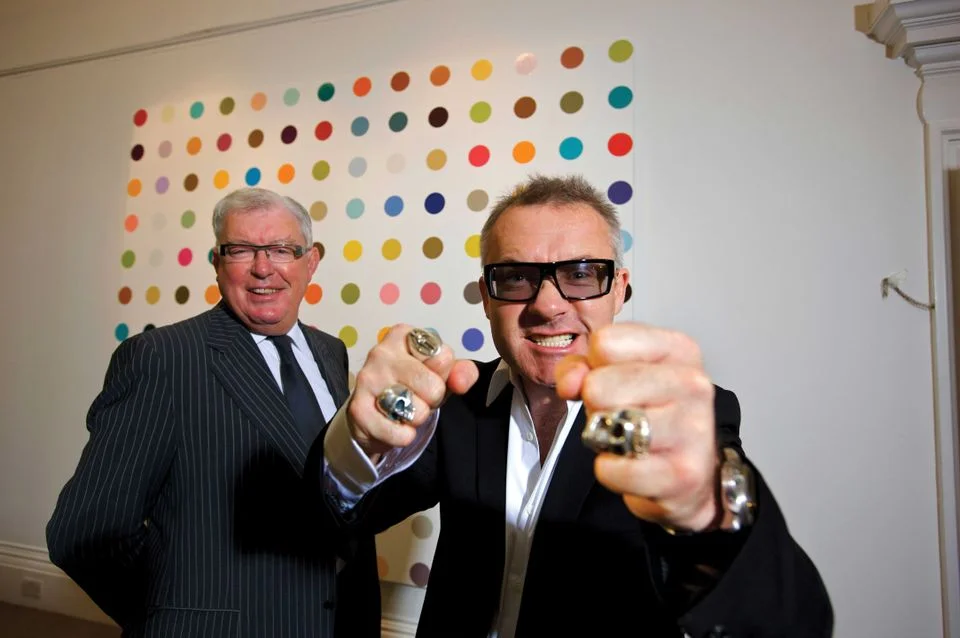The Irishman Who Made Damien Hirst A Star
SOTHEBY’S SALE OF FRANK AND LORNA DUNPHY’S COLLECTION
“Smashed Yellow Ball at Peace”, Damien Hirst
This September Sotheby’s London organised one of its most remarkable auctions of 2018: the sale of “Yellow Ball: The Frank and Lorna Dunphy collection”. Frank and Lorna have been involved in the art scene for over 30 years, during which they bought and collected artworks; this latest collection included over 200 artworks by famous contemporary artists, and totaled 10,088,125 GBP. The result was extraordinary, as the expected total was between £6m and £8.4m: most artworks had several bidders competing for it, resulting in prices exceeding the estimates. The beating heart of this collection is a series of works that Damien Hirst, one of the most famous contemporary artists in the whole world, had made specifically for the Dunphys during the 1990s. However, the exhibition included remarkable works by Tracey Emin and Rachel Whiteread, other famous members of British Contemporary art scene, but also by worldwide recognized artists such as Andy Warhol and Lucio Fontana. The latter’s work, a 1961 cut piece, was sold for £1,174,00 (est. £600,000-800,000), ranking at the top of the entire sale.
Lucio Fontana's cut piece, 1961
Despite hosting works by several renowned artists, Damien Hirst is the name that stands out the most, as his relationship with Dunphy lasted 15 years and it was thanks to that encounter that Hirst started building up his extraordinary career. It is not by chance that the title of the collection is, in fact, taken from “Smashed Yellow Ball at Peace”, a butterfly painting on a yellow background that Hirst gave to Dunphy as a present. The duo met in the early 90s after Hirst’s mother had heard about Dunphy’s practice; they started working together in 1995 and Frank Dunphy was definitely pivotal in his rise to stardom in the art world. Born in Ireland, Dunphy moved to England in the 50s, and ended up representing many artists and actors from the very beginning: his experience and entrepreneurial skills allowed him to grasp Hirst’s talent, and he decided to invest in him.
Artist Damien Hirst with his business manager Frank Dunphy pictured with some of his artworks.
The bond between Dunphy and Hirst was extremely tight, as the two could even be considered “partners in crime” (Sotheby’s). “Behind every great creative genius is a Svengali-type character who helps unleash and channel their brilliance. For Damien Hirst this was Frank Dunphy, whose Midas touch is now legendary”. What Oliver Baker, chairman of Sotheby’s Europe, says in the previous quote explains extremely clearly the type of relationship that was built during those 15 years of partnership. Dunphy saw Hirst’s potential, and he can now be considered a full-fledged artistic celebrity. He played a crucial role in his dynamic and vibrant career path: for instance, by being involved in the 1999 sale where he broke the £1 million barrier. He also participated to the Pharmacy Auction in 2004 and the Beautiful Inside My Head Forever in 2008, which totaled £11.1m and £111m respectively. Their business relationship ended in 2010 when Dunphy decided to retire; however, their bond goes beyond business. Many of the works in the collection were presents Hirst had made specifically for Dunphy: the title of the collection ‘Yellow Ball’, for instance, recalls the circular butterfly painting on a yellow background named “Smashed Yellow Ball at Peace”, which Hirst had given to Dunphy as a present. This is not the only artwork Hirst had made specifically for his long-time friend: the paint-splattered bust (tot.) had been created to celebrate Dunphy’s 70th birthday, while the 1997 pill cabinet was given to him while being sick.
Dollar Sign, Andy Warhol




